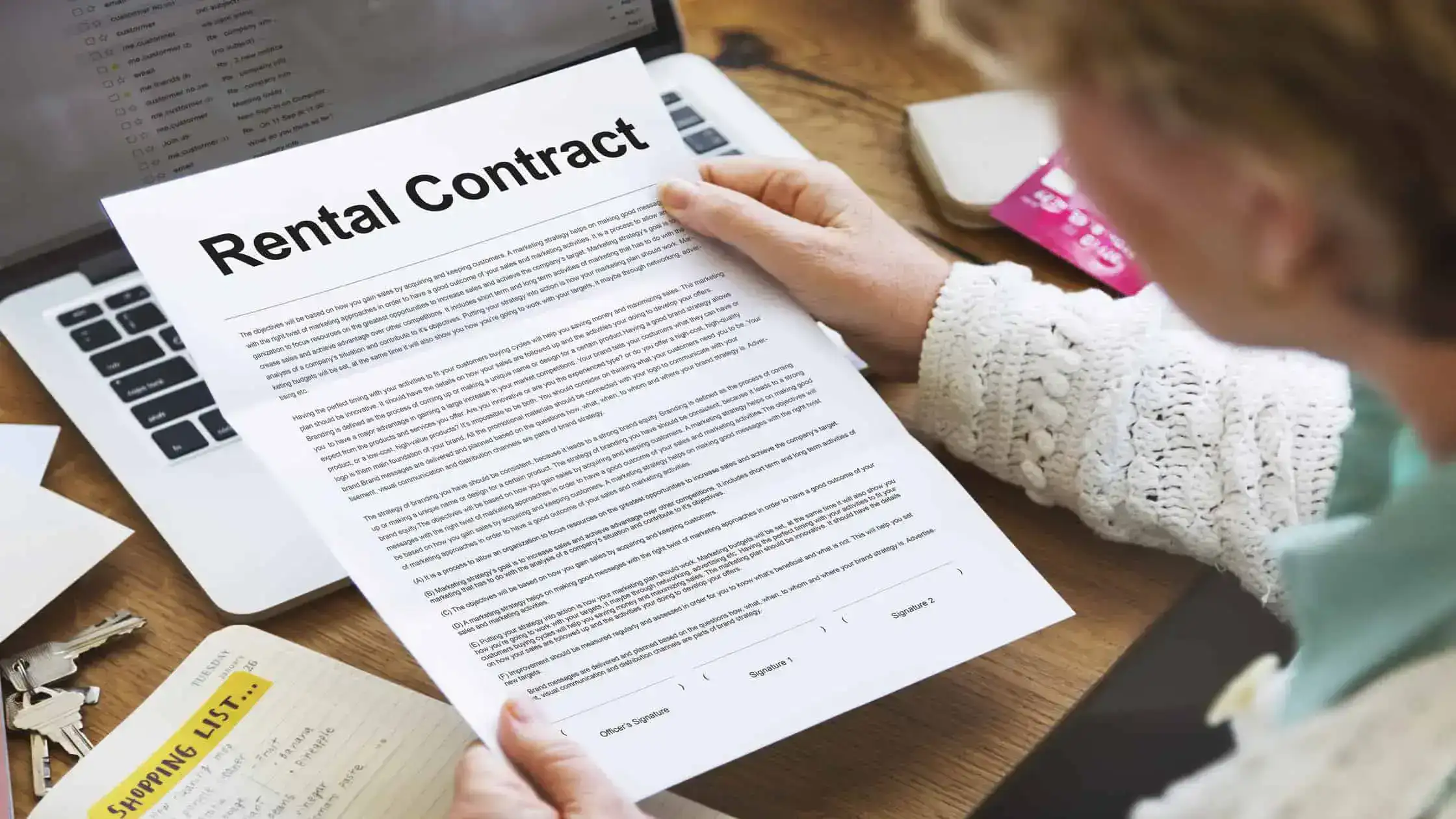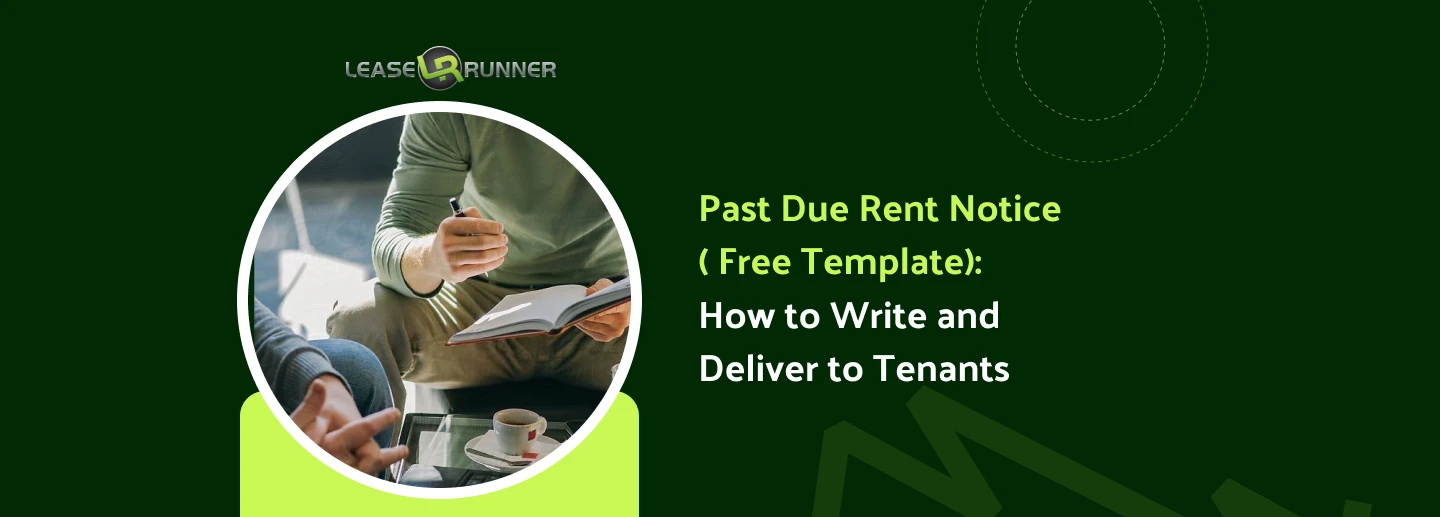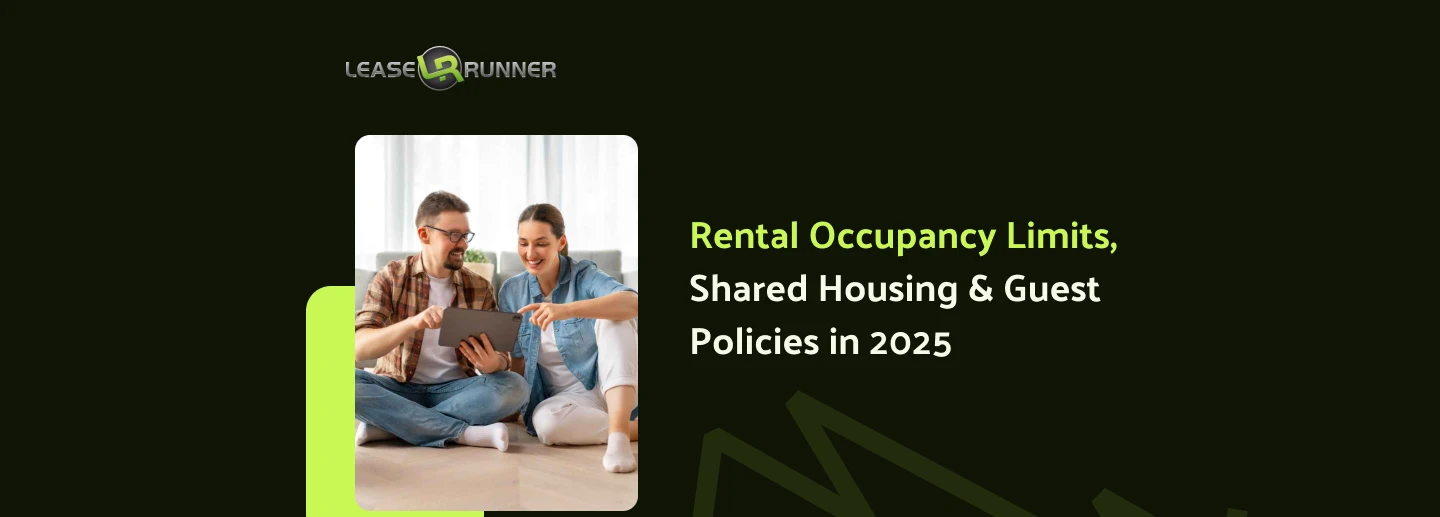A past-due rent notice is the first step landlords use to deal with unpaid rent and protect their income. This written legal rent notice is issued once the grace period in the lease agreement terms has ended—for example, five days after rent is due. It lists the unpaid rent balance, late fees owed, the rental property address, clear payment instructions, and the payment deadline.
Sending it by certified mail gives proof the tenant received it. In states with strict rules, such as California’s pay or quit notice, serving it promptly avoids delays. If ignored, the notice supports eviction notice filings or follow-up action such as the rent collection process. This guide explains step-by-step how to draft, deliver, and enforce notices while avoiding late rent issues in 2025.

Quick Facts About Past Due Rent Notice
What Is a Past Due Rent Notice?
A past due rent notice, also called a late rent notice to the tenant, is a formal document a landlord sends when rent is late. The purpose is direct: to remind the tenant about the unpaid rent balance and to explain the non-payment consequences.
The notice always includes the rental property address, the payment instructions, the payment deadline, and any late fees. This type of legal rent notice is not the same as an eviction notice. Instead, it works as an early step that gives the tenant a chance to pay before the case moves into eviction proceedings.
Delinquent rent, also called rent arrears, happens when a tenant does not pay on the agreed-upon due date under the lease agreement terms. Learning more about rental arrears helps landlords measure what is owed and decide the right action.
For example, if the agreed rent is $1,200 and no payment arrives after the grace period, often 5 days, the landlord may issue a notice. That notice must explain the overdue amount, state any lawful rent late fees, and set a new deadline.
Key Functions of a Past Due Rent Notice
- Documentation: Creates a written record that landlords can rely on later in court.
- Clarity: Explains the total due, adds late fee details, and sets a new payment deadline.
- Compliance: Meets state rules. In California, landlords must issue a 3-day pay or quit notice before filing for eviction.
When written correctly, a past due notice supports the rent collection process, acts as a clear rental payment reminder, and helps landlords avoid late rent issues through proper documentation and legal compliance.
Important Information to Include in a Past Due Rent Notice
A past due rent notice, often called a late rent notice to tenant—must contain very specific information to hold up as a legal rent notice. The goal is not only to notify renters about an unpaid rent balance but also to provide a clear rental payment reminder that outlines both deadlines and the non-payment consequences.
Landlords who prepare a complete document reduce disputes, avoid errors, and improve the chance of settling rent arrears without moving into costly eviction proceedings. When drafting, be sure the following points are clearly included.
- Notice date: Record the date when the document is issued so there is no dispute about timelines.
- Property address: State the full rental property address to link the notice to the correct unit.
- Tenant and landlord information: List both parties’ names and contact details as they appear in the lease agreement terms.
- Overdue rent details: Specify the exact unpaid rent balance, including the billing period missed. Example: “$1,200 due for August.”
- Late fees and penalties: Mention any lawful charges, such as late fees explained under the lease or local ordinances. See best way to collect rent for guidance on applying fees fairly.
- Payment deadline: Give a strict cut-off date that allows tenants a final opportunity to comply. Example: “Payment must be made no later than September 25.”
- Accepted payment methods: Always repeat which forms are valid—check, bank transfer, or online platforms. Avoid cash unless fully received.
- Consequences of non-payment: Describe what happens if tenants ignore the notice, such as serving a pay or quit notice, filing for eviction, or reporting arrears to collections. Details on how many lease violations are required before eviction may also apply.
- Landlord contact information: Provide a phone and email so tenants can request clarification or confirm payment.
- Landlord’s signature: Sign and date the letter to prove it is an official notice.
Past Due Rent Notice Template
A past due rent notice serves as a clear and legal rent notice from landlord to tenant. When rent is late, the letter must be formal and complete so there is no confusion about the unpaid rent balance or the non-payment consequences.
A simple template starts with the tenant’s full name and the rental property address. Here is a sample template you can refer to:
State the total owed, for example, “$1,200 for August rent”—and list any late fees. Add clear payment instructions, such as mailing a check or sending an online transfer. Include a strict payment deadline, like “no later than September 20, 2025.”
Close the letter with a warning that failure to pay may lead to an official pay or quit notice and potential eviction proceedings. End with the landlord’s signature to confirm legal standing.
How to Write a Past Due Rent Notice?
Writing a strong notice involves three steps:
Step 1: Gather Essential Information
Collect all records before drafting. Confirm the lease agreement terms, including the rent due date, any grace period, and late fee limits.
Example: If rent is due September 1 with a 5-day grace period, the notice should be sent on September 6. Include tenant and landlord contact details to avoid disputes.
Step 2: Draft the notice
Make the document simple and clear. List the rental payment reminder, the total balance, late fees, and the final payment deadline. Avoid vague language. Example: “You owe $1,200 rent plus $50 late fee for August.
Payment must be received by September 20, or legal action may follow.” Include accepted payment methods, such as bank transfer or certified check. Short sentences stop tenants from claiming confusion.
Step 3: Serve the Notice
Delivery is where many landlords make mistakes. Always keep proof of delivery. Options include certified mail, in-person delivery with a witness, or posting the notice on the door if state laws allow. For added security, store a copy in the rental file.
If the tenant repeats rent arrears, provide a proof of income letter request or refer to the 3 times the rent affordability rule. This helps ensure tenants can pay on time, reducing long-term risk.
Extra Advice: Send a follow-up notice if payment is still missing. Combine notices with a structured rent collection process to avoid late rent issues and protect your property income.
How to Deliver a Past Due Rent Notice?
Correct delivery is essential. The notice counts as a legal step, so courts require proof. Below are common methods:
Certified Mail
Certified mail is one of the most commonly accepted delivery methods for past-due rent notices. It provides both legal recognition and reliable documentation.
- How it works: The landlord sends the notice through certified mail via the postal service.
- Proof of delivery: Provides tracking and a signed receipt confirming delivery.
- Best for: Notices tied to eviction proceedings where legal proof is required.
In-Person Delivery
Delivering the notice directly to the tenant is a straightforward way to ensure they receive it without delay.
- How it works: The landlord personally hands the notice to the tenant, often with a witness present.
- Proof of delivery: The witness can confirm the notice was given directly to the tenant.
- Best for: Situations where landlord and tenant have ongoing communication, and face-to-face contact is possible.
Electronic communication is becoming more common, but it only works if both parties have agreed to it in the lease.
- How it works: The notice is emailed to the tenant if electronic delivery is authorized in the lease.
- Proof of delivery: The tenant must confirm receipt in writing, such as by replying to the email.
- Best for: Tech-savvy leases where electronic communication is agreed upon in advance.
Posting
When direct contact isn’t possible, posting the notice at the tenant’s residence is another option, if state law permits.
- How it works: The landlord posts the notice on the tenant’s door if the tenant is not reachable.
- Proof of delivery: A dated photo of the posting serves as evidence.
- Best for: States that legally allow posting when other delivery attempts fail.
Substitute Service
In cases where the tenant isn’t available, landlords may deliver the notice to another responsible adult living at the property.
- How it works: The notice is handed to another adult living at the tenant’s residence.
- Proof of delivery: Landlord must document the adult’s name and relationship to the tenant.
- Best for: Cases where the tenant cannot be reached directly, but another household member is available.
Best Practice: Use certified mail for notices connected to eviction notice requirements. This legal standard avoids disputes about whether a tenant received the document. By following state law, observing timelines, and communicating clearly, landlords can enforce the rent collection process, protect income, and avoid late rent issues while maintaining fairness.

When Should You Send a Past Due Rent Notice?
Timing is critical when sending a past-due rent notice. Acting promptly helps protect your legal rights and increases the chance of collecting overdue rent without escalating to eviction.
Timing and Importance
Send the past due rent notice right after the grace period ends. For example:
- Day 1: Rent is due.
- Day 5: Grace period ends (if your lease allows 5 days).
- Day 6: Send a late rent notice to the tenant.
Delaying this notice weakens your legal position. Courts in 2025 favor landlords who follow proper timelines. Prompt action shows you are serious and compliant with state laws.
Stages of Rent Collection
- Grace Period: Allow 3 to 5 days for bank processing or minor delays.
- Initial Notice: Send a late rent notice via email or text to remind tenants.
- Formal Request: If rent remains unpaid, escalate to a formal past due rent notice sent by certified mail. This creates a legal record.
- Legal Action: If unpaid after 10 to 14 days, serve a pay or quit notice, demanding payment or vacating the property.
Case Study
For example, a landlord in Los Angeles avoided a costly eviction by sending a past due rent notice on Day 6. The tenant paid within 48 hours, saving time and legal fees. This example shows how timely notices can resolve late rent issues quickly and efficiently. By following these steps and sending notices promptly, landlords can improve rent collection and reduce disputes.

Legal Considerations and Requirements for Rent Notices
Landlords need to know the law on notices for late rent payments. Laws are quite different from one state and city to another, and studying them closely helps you avoid making errors that cost you money and doing things that are against the law.
State and Local Notice Laws
Each state has its own guidelines concerning when and how landlords must tell tenants about rent hikes or unpaid payments:
- CCP Section 1161 says that California needs a 3-day notice for overdue rent. This implies that landlords have to offer renters three days to pay, or they will have to start the eviction process.
- New York law mandates a 14-day notice before a landlord can begin the process of an eviction for non-payment of rent.
- In Texas, landlords must give tenants a minimum of a three-day written notice to vacate for unpaid rent, unless a different period is agreed upon in the lease.
Local authorities may establish more rules:
- Under the Los Angeles Rent Stabilization Ordinance (RSO), the annual rent increase for RSO units from July 1, 2025, through June 30, 2026, is set at 3%. An additional 1% can be added if the landlord pays for gas and electric service.
- San Francisco requires a minimum 60-day written notice for rent increases of 10% or less, and a 90-day notice for increases over 10%.
To make sure they follow the rules, landlords must keep up with these local changes.
Avoiding Illegal Collection Practices
Landlords must never use illegal tactics to collect rent. This includes:
- Refrain from threatening tenants with violence or harassment.
- Never shut off utilities or change locks to force payment. These actions are illegal and can lead to severe penalties.
- Adhere to the Fair Debt Collection Practices Act (FDCPA). Although the FDCPA primarily applies to third-party debt collectors, some courts have found that landlords or their lawyers may be subject to its rules when attempting to collect rent. The FDCPA prohibits abusive or deceptive collection methods.
For example, a Florida landlord was fined $10,000 for disabling a tenant's HVAC system over late rent. Such actions are illegal and can lead to severe penalties.
What Should Landlords Do If Rent Remains Unpaid?
When tenants do not pay rent, landlords must act fast and smart. They need to get the money owed while following the law and keeping good tenant relations. Here are clear steps landlords can take when rent stays unpaid.
Follow-Up Strategies
- Offer Payment Plans: If tenants have money problems, landlords can let them pay in installments. For example, a landlord might accept $500 a month for three months to cover $1,500 owed. This helps get rent without starting an eviction.
- Use Mediation: Local housing agencies can help landlords and tenants talk and agree on payment plans. Mediation avoids court and saves money. For instance, a Chicago landlord got $4,500 back by making a six-month payment plan through mediation.
Send a Final Delinquent Rent Notice: If the tenant still does not pay, send a formal delinquent rent notice by certified mail. This notice must say how much is owed, the deadline to pay, and what happens if they don't pay, like eviction.
Considering Eviction
- File in Court: If rent is unpaid after all notices, landlords can file an unlawful detainer lawsuit to start eviction. They must show the lease, payment records, and notices.
- Attend Court Hearing: Landlords present proof of unpaid rent and proper notices. Tenants can respond.
- Get a Writ of Possession: If the court agrees, a sheriff can remove the tenant if they don't leave.
- Cost Alert: Evictions cost $3,000 to $10,000 on average. This includes legal fees and lost rent. Eviction should be the last step.
By offering payment plans, using mediation, and clear communication, landlords often get rent without eviction. When needed, following the legal eviction process protects landlords and follows state laws.

How to Prevent Late Rent Payment?
Preventing late rent payments is key to maintaining steady cash flow and reducing landlord-tenant conflicts. Implementing clear policies, thorough tenant screening, and convenient payment options can greatly improve on-time payments and tenant satisfaction.
Tenant Screening and Verification
Use LeaseRunner's tenant screening services to ensure reliable tenants:
- Verify income using the 3x rent rule (tenant's income should be at least three times the rent).
- Check rental history for prior evictions or late payments.
- Review credit scores, aiming for a score of 650 or higher.
For example, a landlord in Denver reduced late payments by 70% after adopting rigorous tenant screening with LeaseRunner.
Clear Lease Terms
Set explicit lease terms to avoid confusion:
- Due Date: “Rent is due on the 1st and is late after the 5th.”
- Late Fees: “A 5% late fee applies after 5 days.”
- Grace Period: “A 3-day grace period is allowed for bank delays.”
Clear terms help tenants understand expectations and consequences.

Encouraging On-Time Payments
- Discounts: Offer a 2% rent discount for early payments, such as paying by the 25th of the month.
- Auto-Pay: Promote LeaseRunner's auto rent collection to simplify payments. Studies show 99% of tenants pay on time when using auto-pay tools.
Foster Good Tenant Relationships
- Communication: Send rent reminders via SMS, like “Rent due in 3 days!”
- Flexibility: Allow partial payments during hardships, such as medical emergencies, to build trust and encourage timely future payments.
By combining screening, clear policies, convenient payment options, and open communication, landlords can significantly reduce late rent payments and improve tenant relations.
Conclusion
A past-due rent notice is the first step landlords take to handle unpaid rent. Sending a clear late rent notice to the tenant helps prompt payment and avoids confusion. Using a simple past due rent notice template ensures all key details are included.
Tools like LeaseRunner's tenant screening find trustworthy tenants, while automated rent collection makes paying easier and reduces late rent. Always keep copies of notices and tenant replies to protect yourself. If rent stays unpaid, send a delinquent rent notice before moving to an eviction notice for late rent.
Acting fast and following state rules helps landlords avoid losses and keep good tenant relationships. Being prepared and clear keeps rent collection smooth in 2025.
FAQs
Q1. How Long Should a Past Due Rent Notice Give Tenants to Pay?
Depending on state rules and lease agreements, the period a past due rent notice provides renters to pay might be anywhere from 3 to 14 days. In California, for instance, landlords typically give tenants a 3-day notice telling them to pay or go. In New York, renters normally get a warning 14 days before anything else happens.
Some jurisdictions say that landlords can't send the notice until the grace period is up, which is usually three to five days after rent is due. This grace period takes into consideration delays at the bank or mistakes by the renter.
Q2. Can I Charge Late Fees in a Past Due Rent Notice?
Yes, landlords may impose late fees as long as the lease explicitly indicates the fines and they follow the legislation in their area. For instance, a lease may provide that if rent is not paid five days after it is due, a 5% late charge would be added. You need to include any late fines in the past due rent notice so that renters know how much they owe in total.
Some places limit late fees to a set percentage or monetary amount, so landlords should check the rules in their area before charging fines.
Q3. What If the Tenant Ignores the Notice?
If a tenant doesn't pay their rent on time, landlords might take the next step and file an eviction notice with the local courts. This legal action starts the eviction process, which might include a court hearing and, if it goes well, a writ of possession that lets the renter be removed.
Before filing, landlords should make sure that all notifications are in line with state legislation and keep records of all correspondence to back up their case. Taking action soon helps safeguard landlords' rights and pushes renters to pay their rent fast.





![What Is an Admin Fee for Apartments? [2025 Landlord’s Guide]](https://www.leaserunner.com/storage/413/01KAJSZKW3TMYDTGTKJV8VHGPN.webp)

